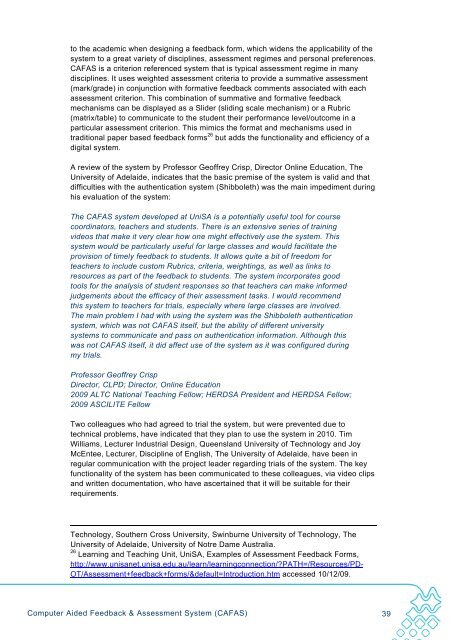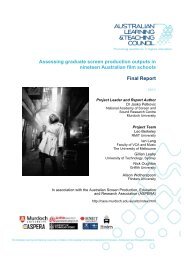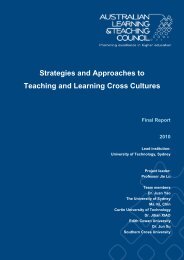PP654 UniSa Freney - Final Report Feb 2010.pdf - Office for ...
PP654 UniSa Freney - Final Report Feb 2010.pdf - Office for ...
PP654 UniSa Freney - Final Report Feb 2010.pdf - Office for ...
Create successful ePaper yourself
Turn your PDF publications into a flip-book with our unique Google optimized e-Paper software.
to the academic when designing a feedback <strong>for</strong>m, which widens the applicability of thesystem to a great variety of disciplines, assessment regimes and personal preferences.CAFAS is a criterion referenced system that is typical assessment regime in manydisciplines. It uses weighted assessment criteria to provide a summative assessment(mark/grade) in conjunction with <strong>for</strong>mative feedback comments associated with eachassessment criterion. This combination of summative and <strong>for</strong>mative feedbackmechanisms can be displayed as a Slider (sliding scale mechanism) or a Rubric(matrix/table) to communicate to the student their per<strong>for</strong>mance level/outcome in aparticular assessment criterion. This mimics the <strong>for</strong>mat and mechanisms used intraditional paper based feedback <strong>for</strong>ms 26 but adds the functionality and efficiency of adigital system.A review of the system by Professor Geoffrey Crisp, Director Online Education, TheUniversity of Adelaide, indicates that the basic premise of the system is valid and thatdifficulties with the authentication system (Shibboleth) was the main impediment duringhis evaluation of the system:The CAFAS system developed at UniSA is a potentially useful tool <strong>for</strong> coursecoordinators, teachers and students. There is an extensive series of trainingvideos that make it very clear how one might effectively use the system. Thissystem would be particularly useful <strong>for</strong> large classes and would facilitate theprovision of timely feedback to students. It allows quite a bit of freedom <strong>for</strong>teachers to include custom Rubrics, criteria, weightings, as well as links toresources as part of the feedback to students. The system incorporates goodtools <strong>for</strong> the analysis of student responses so that teachers can make in<strong>for</strong>medjudgements about the efficacy of their assessment tasks. I would recommendthis system to teachers <strong>for</strong> trials, especially where large classes are involved.The main problem I had with using the system was the Shibboleth authenticationsystem, which was not CAFAS itself, but the ability of different universitysystems to communicate and pass on authentication in<strong>for</strong>mation. Although thiswas not CAFAS itself, it did affect use of the system as it was configured duringmy trials.Professor Geoffrey CrispDirector, CLPD; Director, Online Education2009 ALTC National Teaching Fellow; HERDSA President and HERDSA Fellow;2009 ASCILITE FellowTwo colleagues who had agreed to trial the system, but were prevented due totechnical problems, have indicated that they plan to use the system in 2010. TimWilliams, Lecturer Industrial Design, Queensland University of Technology and JoyMcEntee, Lecturer, Discipline of English, The University of Adelaide, have been inregular communication with the project leader regarding trials of the system. The keyfunctionality of the system has been communicated to these colleagues, via video clipsand written documentation, who have ascertained that it will be suitable <strong>for</strong> theirrequirements.Technology, Southern Cross University, Swinburne University of Technology, TheUniversity of Adelaide, University of Notre Dame Australia.26 Learning and Teaching Unit, UniSA, Examples of Assessment Feedback Forms,http://www.unisanet.unisa.edu.au/learn/learningconnection/?PATH=/Resources/PD-OT/Assessment+feedback+<strong>for</strong>ms/&default=Introduction.htm accessed 10/12/09.Computer Aided Feedback & Assessment System (CAFAS) 39
















